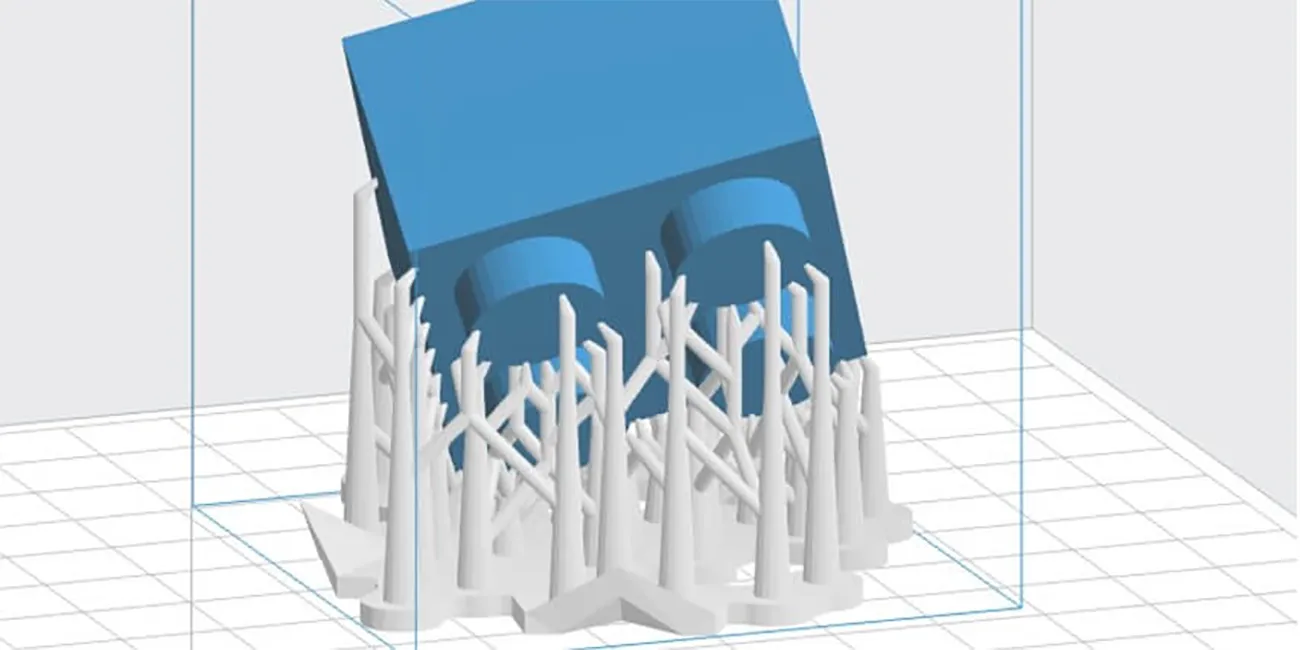
Some 3D printing processes require support structures due to manufacturing constraints. This is necessary to maintain the shape of the objects during the 3D printing process. After the object is completed, the support material needs to be removed, which can be more or less time-consuming depending on the 3D printing process used. Below, we provide a brief overview of support material and structures and explore possibilities to minimize the required material.
Why Use Support Structures?
The Support Structures
Support structures can be categorized into two types based on the 3D printing process: either the support structures are made of the same material as the actual model (Case 1, see below), or they are made of specialized support material different from the model material (Case 2, see below).
- Case 1: Support Material = Model Material: This is the case with stereolithography (or DLP or CLIP) and metal 3D printing. Since support and model are bonded together, there are always ‘scars’ on the surface after removal. In the case of stereolithography, these scars can be relatively well removed (at accessible locations), but the surface is often still somewhat uneven. For metal 3D printing, removal is more difficult and requires extensive post-processing.
- Case 2: Support Material ≠ Model Material: This applies mainly to Polyjet or Multijet Modeling (MJM) 3D printing. In this technology, multiple print heads are used, allowing the support material to differ from the model material. Often, these materials are water-soluble, making support removal easier.
- Special Case Filament 3D Printing (FDM/FFF): In this case, both Case 1 or Case 2 may apply, depending on the material and printer used. For printers with multiple print heads, PVA (Polyvinyl Alcohol) can be used as support material, which is water-soluble. However, its use significantly increases printing time (~factor 3), so we only use it in our 3D printing service for geometrically complex models.
Impact on Surfaces
After 3D printing, the support material typically needs to be removed using manual processes such as scraping, grinding, cutting, sandblasting, etc. At the points where the support material was in contact with the actual object, small “scars” or residues may remain after removal. Through specific post-processing techniques, these “scars” can be effectively removed (except in the case of metal 3D printing, as mentioned above). Generally, these “scars” have minimal impact on the functionality of the objects, but they might create some surface inhomogeneity for certain objects.
Support Optimization
The reduction of required support material begins during the design phase of the object to be 3D printed. By avoiding overhangs or very delicate structures, the necessary support material can be reduced. Another way to reduce support material is to position the object skillfully within the build volume of the 3D printer. For objects requiring high precision or having high aesthetic demands, the build volume positioning also provides good opportunities to place the support in less critical areas.
Therefore, it is helpful to inform us during the order process which areas of the model are particularly important so that we can consider this during the positioning.
Which 3D Printing Processes Require Support Structures?
3D Printing Processes
FDM/FFF
SLA & DLP
SLS
HP Jet Fusion
Polyjet
Colorjet
Metal 3D Printing
Support Structures
Depending on Geometry
Always
Not required
Not required
Always
Not required
Always
Summary
With the exception of powder bed-based 3D printing processes (Colorjet, SLS, Jet Fusion), all processes require support structures depending on the object’s geometry. In some cases, the “support” is made of the same material as the object itself, while for Polyjet or (partially) FDM, the support material differs from the model material.
After 3D printing, mechanical or chemical post-processing processes are necessary to remove the support material. With professional post-processing, residues (“scars”) on the object can be minimized.
About 3Faktur: 3Faktur specializes in 3D printing, rapid prototyping, and rapid manufacturing. We utilize HP’s Multi Jet Fusion technology and offer various materials for prototyping and series production. If you have any questions about your project, feel free to contact us.